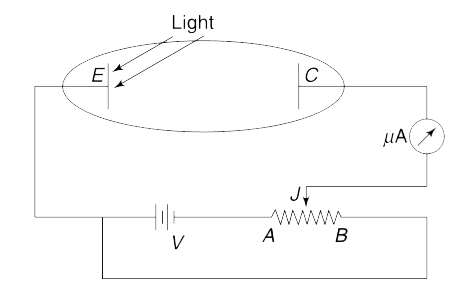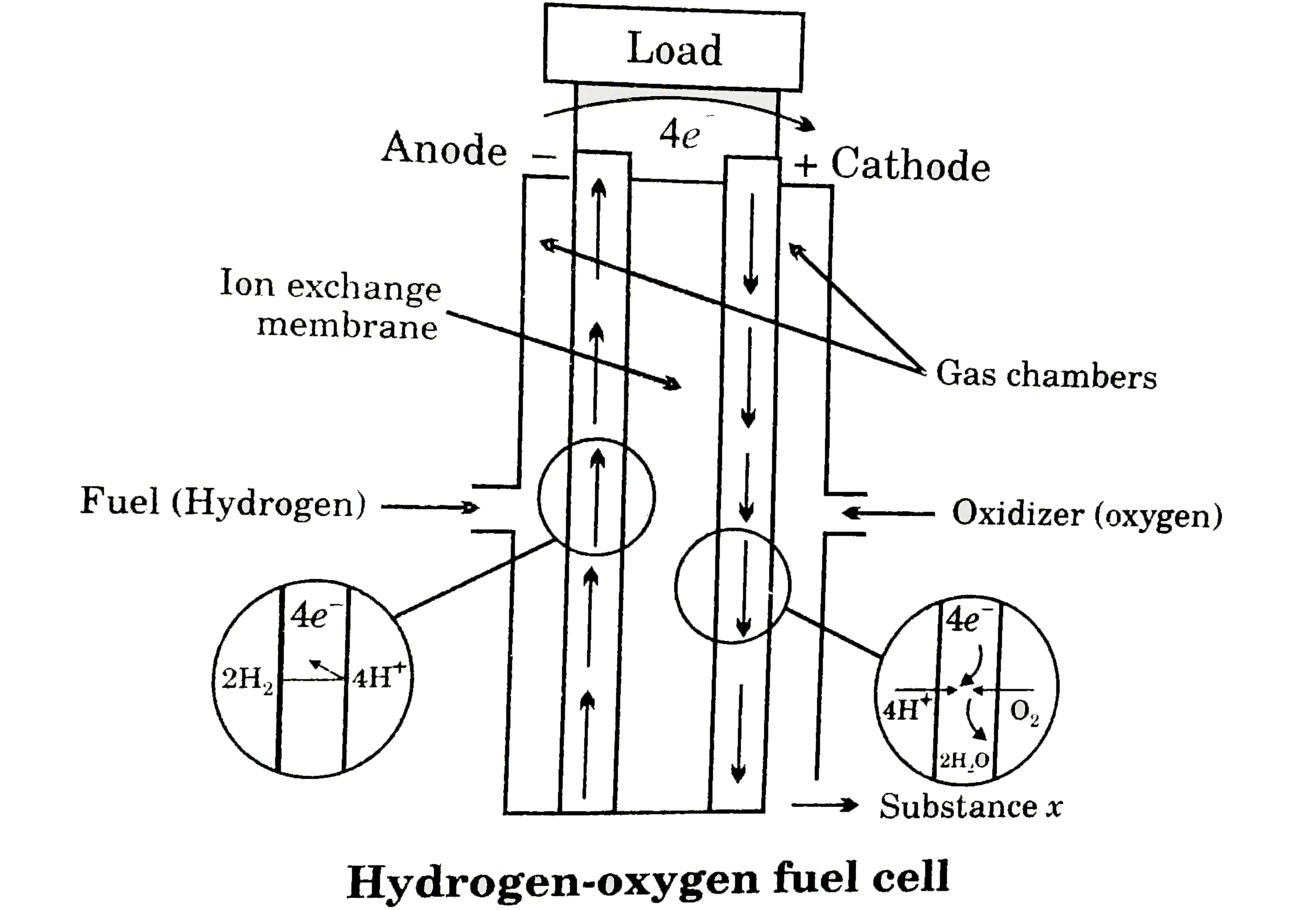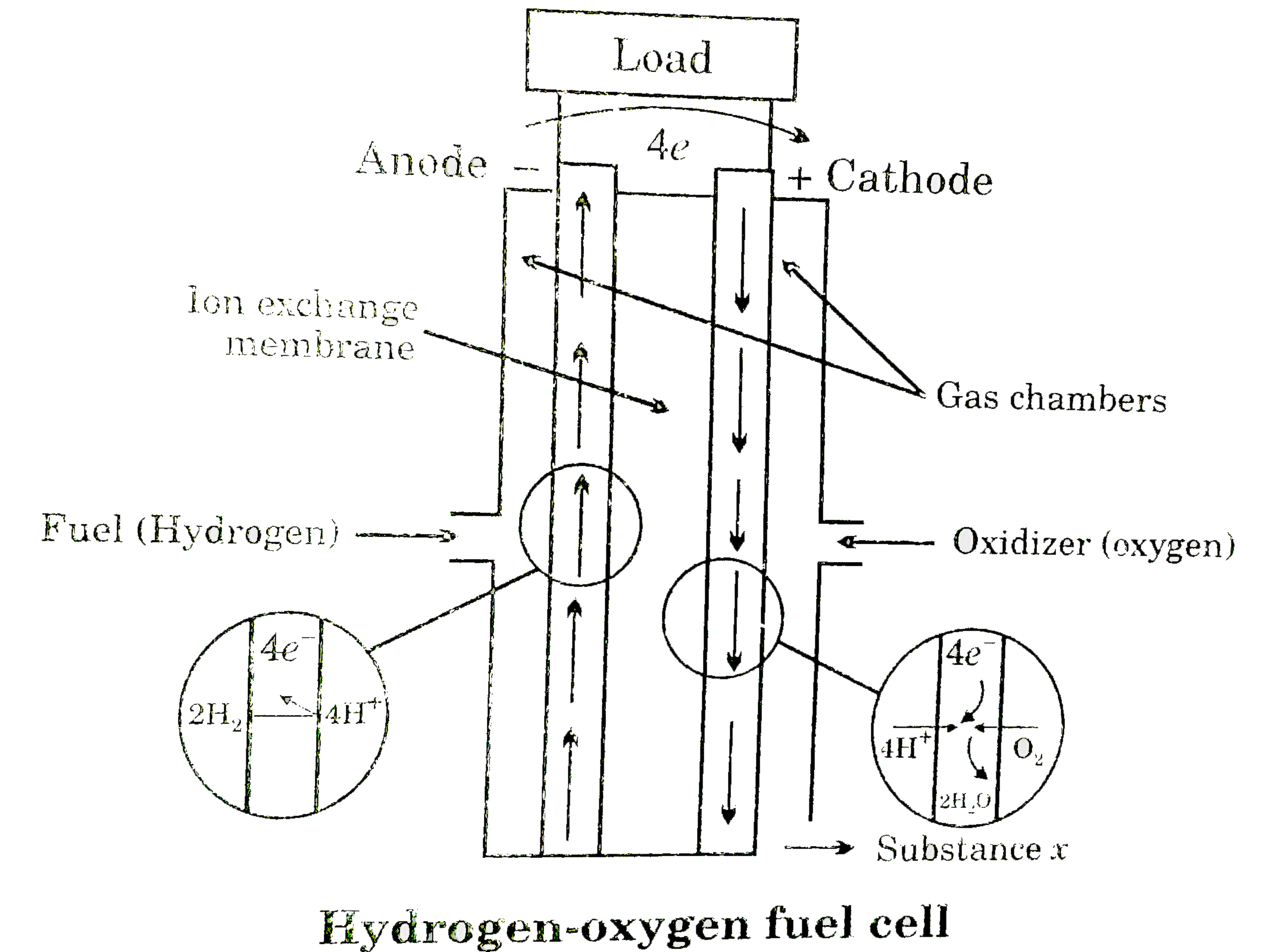Identify the correct statement/s related to polarization in voltraic cell.
(a) When current passes through the voltaic cell, zinc plate starts dissolving in the acid and pro-duces hydrogen bubbles.
(b) These hydrogen bubbles accumulate on the cop-per plate and develop resistance to the flow of current.
Only (A) is true.
Only (B) is true.
Both (A) and (B) are true.
Both (A) and (B) are false.
The correct Answer is:C
When current passes through the voltaic cell, zinc plate starts dissolving in the acid and produces hydrogen bubbles and these hydrogen bubbles accumulate on the copper plate and develop resistance to the flow of current.
Topper's Solved these Questions
Similar Questions
In a photoelectric experimental set-up ultraviolet light of wavelength 350 nm is incident on emitter plate (E). The work function of the emitter plate is ϕ=2.2 eV. AB is a uniform wire resistor having length L=100cm. Resistance of the wire AB is 10 W and the emf of the battery is V=10 volt. The sliding contact J can be moved along the wire AB. When the sliding contact is placed at end B of the wire resistor the micro-ammeter shows a reading of i=6μA. For answering the following questions assume that photoelectric current is very small compared to the current through the cell.
(a) Find the reading of the ammeter when the slider is moved to end A of the wire.
(b) The slider is moved gradually away from A. Plot the variation of ammeter reading versus distance of the slider measured from A.
(c) Find the maximum speed with which an electron will hit the collector plate (C) if slider J is placed at a distance of 95cm from A

View SolutionMaterial : Flexible copper wire, stand, electric cell, a horseshoe magnet with a strong magnetic field. Procedure : Using the stand, fix the copper wire so that it passes through the poles of the horse-shoe magnet as shown in the figure 4.17. Connect the circuit as well. What do you observe? Whenever a current is not flowing through the wire, it remains straight ( position A). When the current flows from top to bottom, the wire bends and comes into position C.If the current direction is reversed, i.e. it flows from the bottom to the top end, the wire bends but comes in the position B. This means the direction of the force on the wire is perpendicular to both the magnetic field and the direction of the current.
Here, the direcțion of magnetic field is from N to S, (H). In this experiment it is noted that whenever a current flows through a conductor in the presence of magnetic field, a force is exerted on the conductor. If the direction of the current is réversed, the direction of the force also gets reversed. If the magnet is kept reversed, i.e. its South pole is brought at the position of its North pole and its North pole brought to the position of its South pole, what will happen?
View Solution
Knowledge Check
Identify the correct statement/s related to polarization in voltraic cell.
(a) When current passes through the voltaic cell, zinc plate starts dissolving in the acid and pro-duces hydrogen bubbles.
(b) These hydrogen bubbles accumulate on the cop-per plate and develop resistance to the flow of current.AOnly (A) is true.BOnly (B) is true.CBoth (A) and (B) are true.DBoth (A) and (B) are false.Indentify the correct statement/s related to local action in a voltaic cell.
(a) Carbon and iron particles present in zinc plate act as impurities.
(b) Impurities react with acid and with the zinc par-ticles to form a large number of tiny cells creat-ing local electric circuits.AOnly (A) is true.BOnly (B) is true.CBoth (A) and (B) true.DBoth (A) and (B) are false.Indentify the correct statement/s related to local action in a voltaic cell.
(a) Carbon and iron particles present in zinc plate act as impurities.
(b) Impurities react with acid and with the zinc par-ticles to form a large number of tiny cells creat-ing local electric circuits.AOnly (A) is true.BOnly (B) is true.CBoth (A) and (B) true.DBoth (A) and (B) false.
(a) When a cell is connected in series with some external resistance, a current α flows through it. When one more identical cell is connected in series with the first one, a current β is found to flow in the circuit. When same cell is connected in parallel with the first one, the current is found to be δ. Find the value of α in terms of β and δ.
(b) It is required to send a current of 8A through a circuit whose resistance is 5Ω. What is the least number of accumulators which must be used for this purpose and how should they be connected ? The emf of each accumulator is 2V and the internal resistance is 0.5Ω.
View SolutionIndentify the correct statement/s related to local action in a voltaic cell.
(a) Carbon and iron particles present in zinc plate act as impurities.
(b) Impurities react with acid and with the zinc par-ticles to form a large number of tiny cells creat-ing local electric circuits.
View SolutionA fuel cell is a cell that is continuously supplied with an oxidant and a reductant so that it can deliver a current indefinitely. Fuel cell offer the possibility of achieving high thermodynamic efficiency in the conversion of Gibbs energy into mechanical work. Internal combustion engines at best convert only the fraction (T2−T1)T2 of heat of combustion into mechanical work. While the thermodynamic efficiency of the fuel cell is give by, η=|ΔG||ΔH|, where ΔG is the Gibbs energy change for the cell reaction and ΔH is the enthalpy change of the cell reaction. This efficiency can be upto 80%-90% also in contrast to normal heat engine efficiency which are generally about 40%

Fuel cells may be classified according to the temperature range in wich they operate low temperature (25 to 100∘C), medium temperature (100 to 500∘C)), high temperature (500to1000∘C) and very high temperature is that catalyst for the various steps in the process are not so necessary. Polarization of a fuel cell reduces the current. Polarization is the result of slow reactions or processes such as diffusion in the cell. The figure indicates the construction of hydrogen-oxygen fuel cell with a solid electrolyte, which is an ion exchange membrane. The membrane is impermeable to the reactant gases, but is permeable to hydrogen ions, which carry the current between the electrodes. To facillitate the operation finely divided platinum that function as a catalyst. Water is drained out of the cell during operation. Fuel cells of this general type have been used successfully in the space program and are quite efficient. their disadvantages for large-scale commercial application are that hydrogen presetns storage problems, and platinum is an expensive catalyst. Cheaper catalysts have been found for higher temperature operatureof hydrogen-oxygen fuel cells. Fuel cells taht use hydrocarbons and air have been developed, but their power per unit weight is too low to make them practical in ordinary automobiles. Better catalysts are needed. A hydrogen-oxygen fuel cell may hae an acidic or alkaline electrolyte. The half-cell reactions are:
12O2(g)+2H++2e−→H2O(l)E∘=1.2288V
2H++2e−→H2(g)E∘=0
H2(g)+12O2(g)→H2O(l)E∘=1.2288V
or 12O2(g)+H2O(g)+2e−→2OH−E∘=0.4009V
2H2O(l)+2e−→H2(g)+2OH−E∘=−0.8279V
H2(g)+12O2(g)→H2O(l)E∘=1.2288V
To maximize the power per unit mass of an electrochemical cell, the electronic and electrolytic resistances of the cell must be minimized. than aqueous solutions, high-temperature electrochemical cells are of special interest for practical applications. High temperature also allow the use of liquid metal electrode, which makes possibel high current densities than solid electrodes.
The advantage of using fuel cell in a motorcar could be:
View SolutionA fuel cell is a cell that is continuously supplied with an oxidant and a reductant so that it can deliver a current indefinitely. Fuel cell offer the possibility of achieving high thermodynamic efficiency in the conversion of Gibbs energy into mechanical work. Internal combustion engines at best convert only the fraction (T2−T1)T2 of heat of combustion into mechanical work. While the thermodynamic efficiency of the fuel cell is give by, η=|ΔG||ΔH|, where ΔG is the Gibbs energy change for the cell reaction and ΔH is the enthalpy change of the cell reaction. This efficiency can be upto 80%-90% also in contrast to normal heat engine efficiency which are generally about 40%

Fuel cells may be classified according to the temperature range in wich they operate low temperature (25 to 100∘C), medium temperature (100 to 500∘C)), high temperature (500to1000∘C) and very high temperature is that catalyst for the various steps in the process are not so necessary. Polarization of a fuel cell reduces the current. Polarization is the result of slow reactions or processes such as diffusion in the cell. The figure indicates the construction of hydrogen-oxygen fuel cell with a solid electrolyte, which is an ion exchange membrane. The membrane is impermeable to the reactant gases, but is permeable to hydrogen ions, which carry the current between the electrodes. To facillitate the operation finely divided platinum that function as a catalyst. Water is drained out of the cell during operation. Fuel cells of this general type have been used successfully in the space program and are quite efficient. their disadvantages for large-scale commercial application are that hydrogen presetns storage problems, and platinum is an expensive catalyst. Cheaper catalysts have been found for higher temperature operatureof hydrogen-oxygen fuel cells. Fuel cells taht use hydrocarbons and air have been developed, but their power per unit weight is too low to make them practical in ordinary automobiles. Better catalysts are needed. A hydrogen-oxygen fuel cell may hae an acidic or alkaline electrolyte. The half-cell reactions are:
12O2(g)+2H++2e−→H2O(l)E∘=1.2288V
2H++2e−→H2(g)E∘=0
H2(g)+12O2(g)→H2O(l)E∘=1.2288V
or 12O2(g)+H2O(g)+2e−→2OH−E∘=0.4009V
2H2O(l)+2e−→H2(g)+2OH−E∘=−0.8279V
H2(g)+12O2(g)→H2O(l)E∘=1.2288V
To maximize the power per unit mass of an electrochemical cell, the electronic and electrolytic resistances of the cell must be minimized. than aqueous solutions, high-temperature electrochemical cells are of special interest for practical applications. High temperature also allow the use of liquid metal electrode, which makes possibel high current densities than solid electrodes.
If 567.5 mL of H2 gas at STP is fed into and is consumed by the cell in 10minutes, then what is the current output (in A) of the fuel cell?
View SolutionA fuel cell is a cell that is continuously supplied with an oxidant and a reductant so that it can deliver a current indefinitely. Fuel cell offer the possibility of achieving high thermodynamic efficiency in the conversion of Gibbs energy into mechanical work. Internal combustion engines at best convert only the fraction (T2−T1)T2 of heat of combustion into mechanical work. While the thermodynamic efficiency of the fuel cell is give by, η=|ΔG||ΔH|, where ΔG is the Gibbs energy change for the cell reaction and ΔH is the enthalpy change of the cell reaction. This efficiency can be upto 80%-90% also in contrast to normal heat engine efficiency which are generally about 40%

Fuel cells may be classified according to the temperature range in wich they operate low temperature (25 to 100∘C), medium temperature (100 to 500∘C)), high temperature (500to1000∘C) and very high temperature is that catalyst for the various steps in the process are not so necessary. Polarization of a fuel cell reduces the current. Polarization is the result of slow reactions or processes such as diffusion in the cell. The figure indicates the construction of hydrogen-oxygen fuel cell with a solid electrolyte, which is an ion exchange membrane. The membrane is impermeable to the reactant gases, but is permeable to hydrogen ions, which carry the current between the electrodes. To facillitate the operation finely divided platinum that function as a catalyst. Water is drained out of the cell during operation. Fuel cells of this general type have been used successfully in the space program and are quite efficient. their disadvantages for large-scale commercial application are that hydrogen presetns storage problems, and platinum is an expensive catalyst. Cheaper catalysts have been found for higher temperature operatureof hydrogen-oxygen fuel cells. Fuel cells taht use hydrocarbons and air have been developed, but their power per unit weight is too low to make them practical in ordinary automobiles. Better catalysts are needed. A hydrogen-oxygen fuel cell may hae an acidic or alkaline electrolyte. The half-cell reactions are:
12O2(g)+2H++2e−→H2O(l)E∘=1.2288V
2H++2e−→H2(g)E∘=0
H2(g)+12O2(g)→H2O(l)E∘=1.2288V
or 12O2(g)+H2O(g)+2e−→2OH−E∘=0.4009V
2H2O(l)+2e−→H2(g)+2OH−E∘=−0.8279V
H2(g)+12O2(g)→H2O(l)E∘=1.2288V
To maximize the power per unit mass of an electrochemical cell, the electronic and electrolytic resistances of the cell must be minimized. than aqueous solutions, high-temperature electrochemical cells are of special interest for practical applications. High temperature also allow the use of liquid metal electrode, which makes possibel high current densities than solid electrodes.
For a hydrogen-oxygen fuel cell if ΔH2f(H2O,l)=−285kJ/mo≤, then what will be its thermodynamic efficiency under standard conditions (use data given in the passage if required)?
View Solution
